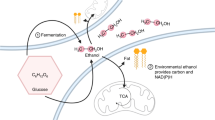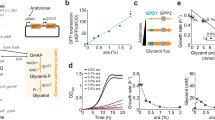Abstract
IT has long been known that glucose represses many inducible enzyme systems1. The mechanism responsible for this specific effect has elicited wide interest although none of the suggestions put forward has received unqualified acceptance. Neidhart and Magasanik2 and Mandelstam3,4 have concluded from their studies on β-galactosidase that any compound utilized by the organism as a source of energy and carbon can act as repressor and that it may not be glucose itself but a catabolite derived from it that is the active repressor. According to the “feedback hypothesis” of Neidhart and Magasanik5 and Vogel6, the formation of each catabolic enzyme is controlled by the intracellular concentration of some particular metabolite which is an immediate or ultimate product of that enzyme and which is also produced from glucose at a rate faster than its utilization for synthetic reactions in the cell. A possible site of glucose action is the release of the enzyme from the RNA template7 or ribosome8.
This is a preview of subscription content, access via your institution
Access options
Subscribe to this journal
Receive 51 print issues and online access
$199.00 per year
only $3.90 per issue
Buy this article
- Purchase on Springer Link
- Instant access to full article PDF
Prices may be subject to local taxes which are calculated during checkout
Similar content being viewed by others
References
Magasanik, B., Cold Spr. Harb. Symp. Quant. Biol., 26, 249 (1961).
Neidhart, F. C., and Magasanik, B., Biochim. Biophys. Acta, 21, 324 (1956).
Mandelstam, J., Biochem. J., 79, 489 (1961).
Mandelstam, J., Biochem. J., 82, 489 (1962).
Neidhart, F. C., and Magasanik, B., Nature, 178, 801 (1956).
Vogel, H. J., in Chemical Basis of Heredity (edit. by McElroy, W. D., and Glass, B.), 276 (Johns Hopkins Press, Baltimore, 1957).
Magasanik, B., Magasanik, A. K., and Neidhart, F. C., in Ciba Foundation Symposium on the Regulation of Cell Metabolism (edit. by Wolstenholme, G. W. D., and O'Connor, C. M.), 334 (J. A. Churchill, Ltd., London, 1959).
Hauge, J. G., MacQuillan, A. M., Cline, A. L., and Halvorsen, H. D., Biochem. Biophys. Res. Commun., 5, 267 (1961).
Bhuwaneswaran, C., Sreenivasan, A., and Rege, D. V., Enzymologia, 23, 185 (1961).
Bhuwaneswaran, C., Sreenivasan, A., and Rege, D. V., Enzymologia, 23, 194 (1961).
Crabtree, H. G., Biochem. J., 23, 536 (1929).
Brin, M., and McKee, R. W., Cancer Res., 16, 364 (1956).
Author information
Authors and Affiliations
Rights and permissions
About this article
Cite this article
SULEBELE, G., REGE, D. Reversal by Phosphate of Glucose Repression of Catalase Synthesis in Saccharomyces cerevisiae. Nature 215, 420–421 (1967). https://doi.org/10.1038/215420a0
Received:
Issue Date:
DOI: https://doi.org/10.1038/215420a0
Comments
By submitting a comment you agree to abide by our Terms and Community Guidelines. If you find something abusive or that does not comply with our terms or guidelines please flag it as inappropriate.



